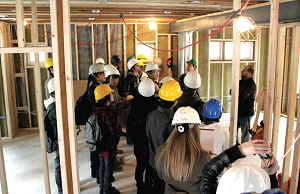TO STUDENTS AT GEORGE BROWN COLLEGE
Towards the end of the summer each year, I begin the search for an old house or small building in need of a “green” retrofit somewhere in downtown Toronto. The search is in preparation for a class project for the advanced Building Science course. The course is attended by approximately 100 second-year students enrolled in the Construction Science and Management degree program at George Brown College. The project spans 3 months, with the objective of developing a comprehensive retrofit plan to upgrade an old building for energy efficiency and sustainability. This project is in its fifth year of running in the program, and each time I never cease to be amazed by the quality and originality of the work the students produce.
codes, aesthetics, neighborhood cohesiveness, energy performance (both passive heat loss and air leakage), occupant health and comfort, durability, costs of materials and labor, scheduling of the work, and the environmental implications of each and every suggestion and material specified, including demolition and material disposal. With all of this to consider, these second year students must draw upon their experience and previous courses in construction technology, construction graphics, building science, estimating, building codes, report writing.

HOUSE GUTTED AND RE-INSULATED WITH ROXUL
The project begins with a site visit to the building, where in groups of 3 or 4, armed with hard hats, boots, tape measures, clip boards and cameras, the students study and document everything of relevance. Each building envelope component
is studied from the foundation up, with special attention paid to insulation levels and types (or more commonly, the lack-of insulation), air-flow/vapour flow control materials/methods, construction methods, and any signs of deterioration.
The second phase of the project begins back on campus as soon as the building surveys are completed. Based on all the site information gathered, the budget given, and any special requests or requirements of the building owners, each group now begins the long and multi-facetted task of designing what they believe to be the best retrofit approach for the building. Each team provides two wall-retrofit options, and one option for each of the other building envelope components. The students must take into consideration lot lines, building and team building skills.

FUTURE PROOFING HARPER AVE. PROJECT – REAR ADDITION AND GUT JOB
At the end of the course, the deliverable is a final report from each group, and a 15 minute presentation to the building owners and students. The reports include extensive write-ups on the history of each building and neighborhood, detailed section drawings of all the relevant components with dew-point analyses (to avoid condensation risks), extensive heat-loss calculations and energy modeling analyses using Hot2000 or REM/Rate software of total building energy consumption (before and after retrofit), and a pay-back projection for each approach. This past year we were lucky in having Mr. Graham Fisher, an energy-modeling expert from Clearsphere Consulting as a guest lecturer to help the students understand some of the intricacies of energy modeling.
Three years ago when the project house was on Harper Avenue, the
renovator managed to achieve an Energuide 79 rating using an interior insulation approach.
Overall, the project has been deemed a success from both the perspectives of the students involved over the years, as well as from the perspectives of the building owners who generously offered their buildings for the students to analyze. Given our vast inventory of old structurally sound, un-insulated and energy-wasting buildings in cities across the continent, which make up the fabric of our older neighborhoods, how better to future proof than to train our future building industry experts with a sound foundation on adaptive reuse approaches. If anyone has such a building which they wish to retrofit in the near future, the students and I would be happy to assist, as project buildings are needed each fall.
CHRIS TIMUSK, PH.D.,PROFESSOR, CENTRE FOR CONSTRUCTION AND ENGINEERING TECHNOLOGIES GEORGE BROWN COLLEGE, CASA LOMA CAMPUSCTIMUSK@GEORGEBROWN.CA











